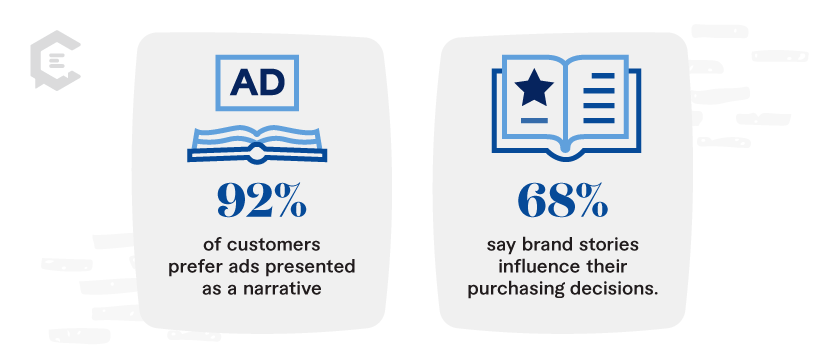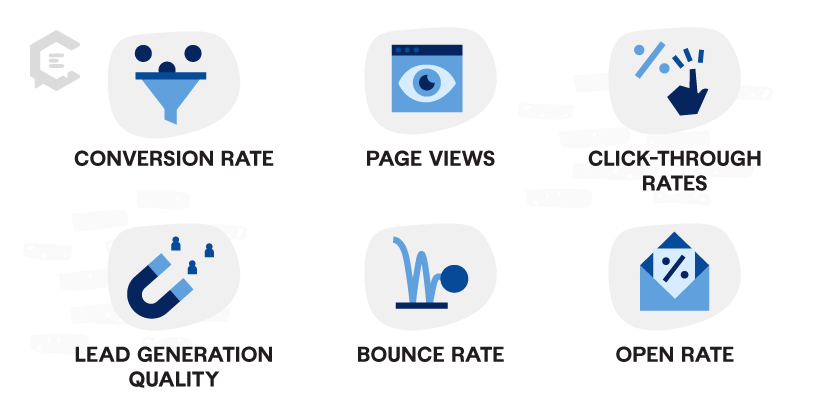We all know the main metric we’re chasing in content marketing — ROI.
Everything we do primarily aims to attract potential customers, engage them, and close the deal. One of the keys to achieving this is creating high-quality content for sales enablement.
In this guide, we’ll cover why content is critical to sales enablement, how to manage your content creation to empower sales, and ways to measure that success.
The Role of Content in Sales Enablement
Content plays a critical role in sales enablement. But before we dive into that, let’s define exactly what sales enablement is.

Understanding sales enablement
Simply put, sales enablement provides your sales team with the content, resources, and tools they need to close a deal.
Your sales team can engage with potential customers at all stages of the buyer’s journey. Quality content equips them with valuable insights and answers to questions that help guide these prospects to take action.
Content also helps your sales team:
- Educate and build authority
- Establish trust
- Anticipate and address objections
But not all content is created equal. Certain types are more effective than others in supporting sales efforts. Those content types include:
- In-depth blogs
- Case studies
- eBooks and white papers
- Explainer videos
- Product or service demos
- Testimonials
The role of content in sales enablement continues beyond supporting your sales team. It can also prime potential customers with information and education before they connect with your sales reps, making it easier to close the deal.
Effective Content Management for Sales
Ideally, your content marketing and sales teams make one another stronger. Custom content will enable your sales team to develop a tailored, solutions-based approach for each lead, and their continuous feedback will help your content marketers expand the company’s reach.
The more effectively you manage your content, the more you’ll empower your sales team. But you need to have a strategic approach in place to ensure your content is:
- High-quality
- Organized
- Easily accessible
- Relevant
- Aligned with the sales process
Let’s explore some strategies and practices to help you manage your content and, ultimately, help sales close deals more efficiently.
Streamlining your content organization
- Consolidate your content into a database: No one wants to waste time looking for the content they need to close deals. Time is of the essence. Put all your content in one easy-to-navigate place. It can be a mix of internal documents, case studies, product or service info, or white papers. The key is ensuring sales can quickly find what they need without having to sift around (This is where a robust CMS can be beneficial)
- Categorize and tag: This is a job for anyone who’s type A on your team. Organize and tag your content based on whatever relevant criteria makes the most sense. It can be by different sales stages, audience segments, or product lines. It’ll help sales find the most appropriate content for their specific needs.
- Leverage technology: Take advantage of technology to streamline operations where you can. For example, a CMS (content management system) can be a game changer in helping your sales and marketing teams organize your high-value content assets so they’re easy to find. Just make sure the system also has capabilities for analytics and can be integrated with other sales tools like CRM systems.
A quick tip: The more organized your content operations are already, the easier it will be to stay organized here.
Aligning your content with sales goals
There needs to be a strong alignment between sales goals and the content being produced. Breaking through content silos and encouraging interdepartmental communication goes a long way. Schedule regular meetings between sales and marketing teams to pinpoint the types of content that are the most effective in the sales process and identify gaps you need to fill.
How to break it down
Your sales enablement content doesn’t just need to be tailored for each phase of the buyer’s journey. It also needs to be tailored specifically for each buyer.
Building a single message and expecting it to appeal to every possible customer is like writing a book for kids and expecting teenagers to respond the same as preschoolers. Here’s what to do to develop content with a sales focus:
- Map out the Buyer’s Journey and Personas: Start with understanding your target audience. Create your personas and build out the journeys for each. What are their pain points and needs? What are they looking for at each stage of their journey? Tailor your content accordingly.
- Define Clear Objectives: Identify specific sales objectives you want to achieve. Is it lead generation? Nurturing? Conversion? Those goals will affect the content you create.
- Leverage Sales Insights: Collaborate closely with your sales team. Use the insights they’ve learned during their sales conversations with customers. Ask them about any common challenges, questions, or struggles they encounter.
- Refine and adjust: Continuously measure the success of your sales content. Analyze each piece of content and pinpoint what’s working and what’s not. Then, make adjustments as needed.
Creating content that supports sales
Including your content team in your sales process allows your company to:
- Create a unified message across departments, maintaining brand consistency
- Develop custom messaging to appeal to individual buyer needs
For example, let’s say a potential customer does a quick Google search about your product or service. To establish a connection immediately, your content should:
- Speak directly to the needs and problems of individual buyer personas
- Anticipate and answer common questions your buyer personas will have
- Offer solutions that satisfy and excite them, inspiring them to take action
Your sales team doesn’t have the time or knowledge to provide the vast amount of content required to meet the increasing demand for information — and they shouldn’t try. Their skill is selling. Yours is storytelling.
Harnessing the power of storytelling
As a marketer and creator, you’re uniquely qualified to craft content that educates an audience through storytelling while establishing an emotional connection with them. That emotional connection is essential to building trust and inspiring them to purchase from your brand.
Ninety-two percent of customers prefer ads presented as a narrative, and 68 percent say brand stories influence their purchasing decisions. That’s because, as human beings, our brains are wired to respond to stories. Using that fact in your content helps:
- Attracts your audience: The buyer’s journey is a natural structure for storytelling. It presents challenges that people identify with, focuses on the emotional elements of that challenge, and then offers the triumph (solution) of overcoming them.
- Motivates through emotion: A study by Motista found that emotionally connected customers have a 306 percent higher lifetime value and rate brands more positively than satisfied customers. When you speak to people’s emotions, they’re more likely to remember your brand and buy more often.
- Build trust: Sharing the value your product or service can bring through a narrative can help you build trust and credibility with your audience. That credibility is a key ingredient for driving conversions and improving customer loyalty.
What type of content should you create?
Don’t be afraid to develop a diverse range of content your sales team can use.
If you’re launching an email nurturing campaign, provide your sales reps with easy-to-locate and easy-to-customize communications they can distribute to targeted personas based on where each persona is within the sales cycle.
As your sales team engages on social media, a readily available library of content solutions enables them to quickly share the appropriate content for their audience. It also helps them to respond to questions with targeted answers.
Perform regular content audits
You don’t want outdated content to hinder sales efforts and damage credibility. Periodically review your content library to ensure all your materials are up-to-date, accurate, and in line with current marketing trends. If things feel outdated, it’s time for some content pruning.
Establish a feedback loop where your sales time and give you input on the effectiveness of the content. That feedback will help you continuously improve and update the content to match what they’re experiencing with customers.
Measuring Your Sales Enablement Success
There’s always room for improvement with your sales enablement content. Let’s talk about some key ways you can measure and track the success of your content.
Measuring key performance indicators (KPIs)
The most effective measurement in content marketing starts with identifying and tracking the right KPIs. Here are some of the top ones you should track for your sales enablement:
- Conversion Rate
- Page views
- Click-through rates
- Lead generation quality
- Bounce rate
- Open rate
That will inform any adjustments you make to your creation and strategy.
Tracking the impact of content on sales
As you create content, you need to know how it influences sales. Here are a few ways you can track it:
- Content attribution: Utilizing content attribution helps you identify and demonstrate proof of success with your content. It shows you what’s working and what’s not. Being able to accurately measure the precise impact of each piece of content is invaluable. There are several attribution models to choose from.
- Sales Funnel Analysis: Because the buyer’s journey is so important, you’re going to want to measure the success of your content at each stage. Is your top-of-funnel content crushing, but you’re middle-of-funnel struggling? That type of data will help you shore up the gaps in content areas that need improving.
- Closed-Loop Reporting: Closed-loop reporting is a system where data collected by both marketing and sales are made available to both teams. Sharing data will help both departments work together and stay on the same page.
Analyzing your data
You can adapt and refine your strategies with data to maximize their effectiveness. Here are some ways you can use data to drive your content’s success:
- A/B Testing: A/B testing can help you elevate specific content elements. Testing different headlines, visuals, and CTAs can help determine which versions resonate best with your audience.
- Audience segmentation: We mentioned buyer personas already. Data is extremely helpful in segmenting your audience to create those personas. It can be a great resource on audience demographics, behavior patterns, and engagement levels. That can inform how you tailor your content for more personalized outreach.
- Feedback Loops: Your marketing and sales team should have consistent communication. Giving feedback to each other will maximize the effectiveness of your content and increase your possibility of success.
Ready to Create Content for Sales Enablement?
The success of both your content marketing and sales teams hinges on how many deals you’re closing. It’s essential that each department supports and enhances the other.
But if you want to create high-quality content that drives leads and conversions right now, ClearVoice has you covered. Our managed content creation teams and experienced creators can help you consistently produce top-tier content that connects with your customers and skyrockets your brand’s success. Speak with a content strategist today to find out how.









